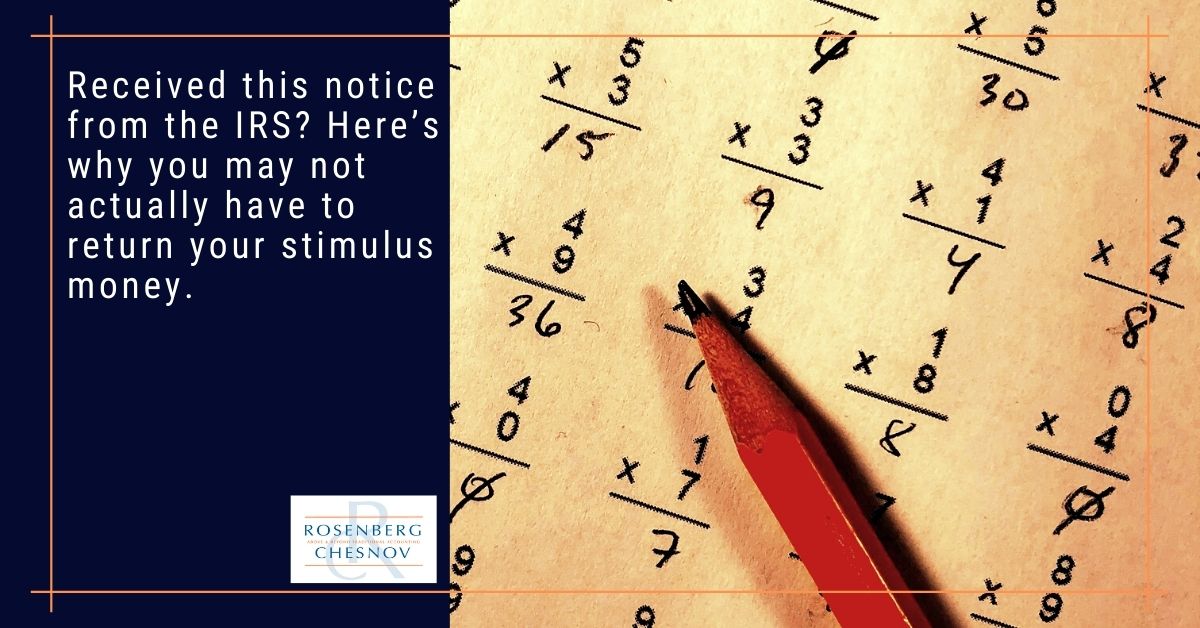

Tax Breaks for Charitable Giving: Maximize Your Impact and Your Savings
Category: Business
Are you feeling duped?
If you claimed your pandemic stimulus payment as a tax credit on your return in 2020, you might be among the millions of people wondering how to react to the confusing math error notices sent this year by the IRS.
The letters, mailed between January 1st and mid-August of 2021, informed recipients that they had to pay back some of their stimulus funds or that their refunds had been reduced due to an overpayment.
Also, the first notice was the “final notice,” the letter was hard to understand, and many letters neglected to inform taxpayers of their full legal rights.
Some recipients even mistook the notice for a scam!
So what’s the good news?
You may have received this notice by mistake.
The IRS sent 11 million math-error notices this year. This was a dramatic increase from the 2 million sent in pre-pandemic 2019. However, many of these, it turns out, were errors.
In the few cases we have seen here at Rosenberg & Chesnov, the IRS has been in the wrong every time.
To be clear: if the IRS is correct, and you do owe more money, then you will have to pay it back. But just because you received a math error notice regarding your stimulus check, that does not necessarily mean the information is accurate.
Read on to learn more about this IRS notice, why you may have received it, why you may not actually have to pay back your stimulus money, and what you can do.


Despite the name, arithmetic mistakes are only one part of “math error” authority. The IRS sends math-error notices due to various issues detected during returns processing, which require adjustment.
The IRS can make the necessary adjustments thanks to Section 6213 of the Internal Revenue Code. This section of the law provides an exception to normal restrictions on assessing a taxpayer’s return. The “math error” authority gives the IRS the power to quickly resolve simple mistakes on a tax return and assess additional tax.
Under this tax code section, the IRS can quickly assess and correct miscalculations, clerical errors, inconsistent entries, omissions of information, and deductions or credits that exceed limits.
The IRS then notifies the taxpayer of any corrections made to their return, which can result in an adjusted refund amount…or balance due.
There are two types of math-error notices the IRS will typically issue: the CP11 and CP12.
If you receive either a CP11 or CP12 notice by mail, it means the IRS has corrected something on your tax return.
The CP11 applies when there is a miscalculation on your return, and you owe more money due to the correction.
The IRS issues a CP12, on the other hand, when one or more mistakes either cause you to be due a refund or cause your original refund amount to change.
If you agree with the information on your CP11, you must pay the amount owed by the date indicated or make payment arrangements if you cannot pay the total amount. If your CP12 is correct, you don’t have to do anything; your refund check will arrive in 4-6 weeks.
However, if you disagree with the notice, you must contact the IRS within 60 days to appeal the decision.
The right to appeal is the critical information that the IRS omitted from the notices received by many taxpayers this year. The omission led to a follow-up letter which, in some cases, only added to the confusion.
The majority (more than 80%) of notices issued this year went to filers who claimed the Recovery Rebate Credit on their 2020 returns. The first two rounds of stimulus checks were advance payments on this credit. So most people who were eligible received their funds directly as an economic impact payment.
But some people who were eligible for stimulus did not receive their checks or got less than the full amount. They were able to claim their credit on their tax returns and receive their stimulus funds in this way.
The IRS has now notified many taxpayers that they weren’t eligible for the recovery rebate they claimed or that the rebate amount would be smaller after adjustment.
It is worth mentioning that there are certainly valid reasons why this may be the case. For example, the third stimulus check came with an income cutoff; if your income is higher and you still received a check, you will likely have to return some or all of it.
You may also have to return your payment if:
Nevertheless, many taxpayers who have received these notices do not fall under any of these categories. WCVB, an ABC-affiliated television station based in Boston, reported on the case of Massachusetts woman Natalie Bonelli, who claimed a missing payment after her stimulus check went to the wrong address—only to receive a notice informing her that she owed that money back.
If you believe you were eligible for the Recovery Rebate Credit that you claimed, but the IRS disagrees, there is the possibility that, like Natalie Bonelli, you are correct and the IRS is wrong.
(For more on COVID-19 relief eligibility, take a look at our blog post addressing the topic.)
As Taxpayer Advocate Service outlines here, the omission of information regarding the 60-day deadline from over five million notices represents an infringement on taxpayer rights. To address this problem, the IRS is issuing a supplemental letter that explains those rights and resets the 60-day clock.
You can appeal the math-error letter and request an abatement for the amount owed within that supplemental 60-day timeframe. However, you will likely have to support your case with documentation that demonstrates your eligibility for the Recovery Rebate Credit that you claimed.
You can substantiate your claim and raise your chances of having the math error reversed by providing missing or incorrect information.
Unfortunately, the supplemental letters the IRS is issuing do not explain why the assessment happened in the first place. This may make it difficult to understand what sort of documentation you will need to substantiate your claim.
If the IRS disagrees that the documentation substantiates your claim, they may refer the case for audit, at which point you can file a petition in the US Tax Court.
You also have the option to file a refund suit in the US District Court or the Court of Federal Claims. However, this course would require you to pay the amount owed beforehand.
Are you feeling a little confused? You are not alone. All the same, you do have options. The first step is to determine whether or not the notice you received was an error.
If you are in doubt, Rosenberg & Chesnov stands ready to assist you in understanding and navigating your options after receiving a math error notice.
If you are a client and would like to book a consultation, call us at +1 (212) 382-3939 or contact us here to set up a time.
If you aren’t a client, why not? We can take care of your accounting, bookkeeping, tax, and CFO needs so that you don’t have to worry about any of them. Interested? Contact us here to set up a no-obligation consultation.
Interested in receiving updates in your mailbox? Check out our newsletter, full of information you can use. It comes out once every two weeks, and you can register for it below.


Category: Business


Category: Business
Send us a message and we will contact you as soon as possible.
Jeff Coyle, CPA, Partner of Rosenberg Chesnov, has been with the firm since 2015. He joined the firm after 20 years of business and accounting experience where he learned the value of accurate reporting, using financial information as a basis for good business decisions and the importance of accounting for management.
He is a diligent financial professional, able to manage the details and turn them into relevant business leading information. He has a strong financial background in construction, technology, consulting services and risk management. He also knows what it takes to create organizations having built teams, grown companies and designed processes for financial analysis and reporting.
His business experience includes:
Creating and preparing financial reporting, budgeting and forecasting.
Planning and preparation of GAAP and other basis financial statements.
Providing insight on financial results and providing advice based on those results.
Jeff also has a long history of helping individuals manage their taxes and plan their finances including:
Income tax planning and strategy.
Filing quarterly and annual taxes.
Audit support.
General financial and planning advice.
Prior to joining the firm in 2015, Jeff was in the private sector where he held senior financial and management positions including Controller and Chief Financial Officer. He has experience across industries, including construction, technology and professional services which gives him a deep understanding of business.
Jeff graduated from Montclair State University, he is a CPA and member of the American Institute of Certified Public Accountants, New York State Society of Certified Public Accountants and New Jersey State Society of Public Accountants.
Jody H. Chesnov, CPA, Managing Partner of Rosenberg Chesnov, has been with the firm since 2004. After a career of public accounting and general management, Jody knows the value of good financials. Clarity, decision making, and strategy all start with the facts – Jody has been revealing the facts and turning them into good business results for more than three decades.
He takes a pragmatic approach to accounting, finance and business. His work has supported many companies on their path to growth, including helping them find investors, manage scaling and overcome hurdles. His experience and passion for business reach beyond accounting and he helps businesses focus on what the numbers mean organizationally, operationally and financially.
He has a particular expertise in early-stage growth companies. His strengths lie in cutting through the noise to come up with useful, out of the box, solutions that support clients in building their businesses and realizing their larger visions.
Prior to joining the firm in 2004, Jody was in the private sector where he held senior financial and management positions including General Manager, Chief Financial Officer and Controller. He has experience across industries, which gives him a deep understanding of business.
Jody graduated with a BBA in Accounting from Baruch College, he is a CPA and member of the American Institute of Certified Public Accountants and New York State Society of Certified Public Accountants.
In addition to delivering above and beyond accounting results, Jody is a member of the NYSCPA’s Emerging Tech Entrepreneurial Committee (ETEC), Private Equity and Venture Capital Committee and Family Office Committee.
He is an angel investor through the Westchester Angels, and has served as an advisor for many startup companies and as a mentor through the Founders Institute.